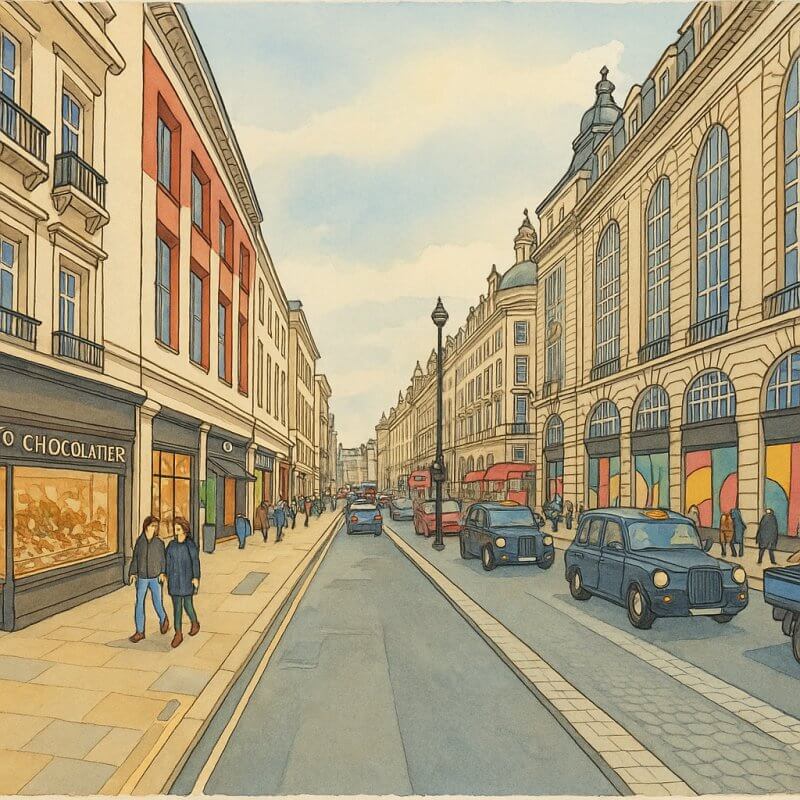
Piccadilly, London
A historic street that links elegance, history, and the heart of the West End
Where is Piccadilly?
Piccadilly is located in the heart of London's West End, running in a west-to-east direction between Hyde Park Corner and Piccadilly Circus. It is part of the City of Westminster and serves as one of the main arteries of central London, forming a prominent boundary between the affluent districts of Mayfair to the north and St James’s to the south.
How Long is Piccadilly, and Is It Also an Area?
The street stretches for approximately 0.75 miles (1.2 kilometres) from Hyde Park Corner in the west to Piccadilly Circus in the east.
While the name Piccadilly primarily refers to the street itself, the surrounding locale, especially near Piccadilly Circus, is sometimes loosely referred to as “the Piccadilly area.” However, it is not officially recognised as a separate district like Mayfair or Soho.
The Origins and History of Piccadilly
The route of what is now Piccadilly can be traced back to medieval times when it was little more than a country lane known as "Portugal Street" in the 17th century. It connected the village of Knightsbridge to the area now known as Soho.
By the 18th century, the street had evolved into a fashionable residential and commercial district, lined with aristocratic mansions, private clubs, and elegant shops. Its proximity to the royal parks and palaces helped enhance its prestige, and it gradually became one of London’s most prominent thoroughfares.
Piccadilly saw numerous transformations in the 19th and 20th centuries with the expansion of commercial enterprises, road developments, and the establishment of key landmarks that still stand today.
How Did Piccadilly Get Its Name?
Piccadilly derives its name from the term “piccadill” – a type of fashionable stiff collar made of lace that was popular in the late 16th and early 17th centuries. A wealthy tailor named Robert Baker made his fortune selling these collars and used the money to build a large house near what is now Piccadilly Circus. The house came to be known as Piccadilly Hall, and over time, the name was applied to the surrounding area and road.
The name Piccadilly became officially established in the late 17th century, replacing earlier names like Portugal Street.
The word is commonly pronounced as:
- “Pick-a-DIL-ee”
- IPA pronunciation: /ˌpɪkəˈdɪli/

Map of Piccadilly, London
Roads Connecting to Piccadilly?
- Albemarle Street
- Berkeley Street
- Bolton Street
- Brick Street
- Clarges Street
- Hamilton Place
- Knightsbridge
- Old Park Lane
- Park Lane
- Regent Street
- Shaftesbury Avenue
- St James’s Street
- Stratton Street
- White Horse Street
Sights along Piccadilly
- Fortnum & Mason (GPS: 51.50836, -0.1383)

Major Buildings and Landmarks Along Piccadilly
Piccadilly is home to several iconic buildings and institutions that reflect its historic and cultural significance. Among them:
- Ritz Hotel – One of London’s most luxurious and famous hotels, opened in 1906.
- Royal Academy of Arts – Founded in 1768 and located in Burlington House, it hosts exhibitions and promotes the visual arts.
- Fortnum & Mason – An iconic department store established in 1707, known for its luxury goods, tea, and hampers.
- Burlington Arcade – A beautifully preserved 19th-century shopping arcade full of exclusive boutiques.
- St James’s Church, Piccadilly – Designed by Sir Christopher Wren and consecrated in 1684, it remains a place of worship and community activity.
- Albany – A prestigious residential complex that has housed many notable figures, including Lord Byron.

Painting of Piccadilly (View full-size image here)
Nearest Underground Stations and Tube Lines
Several London Underground stations provide convenient access to Piccadilly:
- Green Park Station – Located at the western end of Piccadilly. Served by the Piccadilly, Jubilee, and Victoria lines.
- Piccadilly Circus Station – Located at the eastern end. Served by the Piccadilly and Bakerloo lines.
- Hyde Park Corner Station – A short distance west of Piccadilly. Served by the Piccadilly line.
Fun Facts About Piccadilly
Piccadilly is more than just a busy street — it has a few fascinating quirks and facts that even some Londoners might not know:
- The Piccadilly line on the London Underground is named after the street, reflecting its importance in the city's layout.
- Piccadilly once hosted the grand mansion of the Earl of Burlington, known as Burlington House, which is now home to several learned societies and the Royal Academy of Arts.
- Queen Elizabeth II was born just off Piccadilly, at 17 Bruton Street, Mayfair – only a few minutes' walk from the street.
- The name “Piccadilly Circus” is often mistaken for an actual circus or performance venue. In this context, “circus” means a circular traffic junction or public space – similar to Oxford Circus or Cambridge Circus.
- Lord Byron, W. H. Auden, and Terence Rattigan all once lived in Albany, the exclusive residence on Piccadilly.
Why Piccadilly Remains Important Today
Piccadilly continues to play a vital role in London life, balancing its historic grandeur with contemporary culture. From hosting luxury hotels and elegant shops to being a gateway to major attractions like Green Park and Piccadilly Circus, the street is a hub of activity for tourists and locals alike.
Its position between Mayfair and St James’s makes it a prime location for walking tours, cultural exploration, and even celebrity spotting. Whether you’re enjoying afternoon tea at Fortnum & Mason, catching an exhibition at the Royal Academy, or simply strolling down its storied pavement, Piccadilly offers a quintessentially London experience.